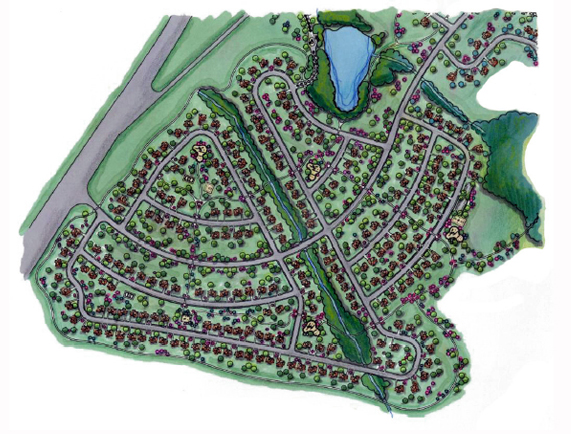Sustainable Site Design
Sustainable site design is not a new concept. Air Force designers, planners and programmers will find that they have been utilizing sustainable design strategies for years out of a desire to promote the most explicitly functional, environmentally friendly and practical infrastructure at their installation. This toolkit is an acknowledgement of those practices and an encouragement to learn about additional opportunities and alternatives for sustainable site design.
 Sustainable design is commonly interpreted as a means to address environmental concerns or Federal mandates that drive water and energy efficiency. While this is true there are other benefits that may be attained by implementing sustainable design strategies. The planning and design community has agreed upon three categories that benefits of sustainable design fall under: Sustainable design is commonly interpreted as a means to address environmental concerns or Federal mandates that drive water and energy efficiency. While this is true there are other benefits that may be attained by implementing sustainable design strategies. The planning and design community has agreed upon three categories that benefits of sustainable design fall under:
- environmental
- social
- economic
Many design strategies have evolved to address all three of these
categories. For example, an intensive
green roof implemented with
the intention of addressing stormwater runoff (environmental
benefit) also provides a pleasant environment for Airmen to enjoy
(social benefit) and improves building insulating properties
resulting in lower utility expenses (economic benefit).
Figure 1. Environ, Social, Economic triangle
Generally speaking, the intent of this toolkit is to assist with the integration of sustainable guidelines on Air Force Installations in order to reduce environmental impacts and operational expenses. More specifically, the toolkit will present sustainable design strategies that will support the requirements of the Energy Independence and Security Act of 2007 (EISA 07), Energy Policy Act of 2005 (EPAct 05) and Executive Order (EO) 13243. The toolkit will also directly support efforts to meet the intent of the Leadership in Energy and Environmental Design (LEED) credit requirements through the evaluation tool that allows the user to assess a site plan or the installation as a whole against LEED and Low Impact Development (LID) recommendations.
There are numerous other regulations that should be considered in conjunction with sustainable design such asUFC 4-010-01, DoD Minimum Antiterrorism Standards for Buildings. Designers, planners and programmers should refer to all appropriate guidance documents when planning for future development or demolition in order to maximize synergies with sustainable strategies.
 Figure 2. Site plan with creek going through Sustainable site design elements are often suggested after the
programming phase of a project has taken place rendering the
sustainable design suggestions irrelevant. For this reason,
programmers are greatly encouraged to utilize this tool. Some
sustainable design suggestions, such as
detention ponds or
solar
energy, may benefit multiple sites therefore planners are also
encouraged to utilize this tool.
Sustainable design strategies within this toolkit have been chosen based on their ability to meet the intent of LEED for New Construction Version 2.2 requirements as well as Government and Air Force regulations. There are numerous design and planning strategies that are simple and inexpensive to employ on a site. A rain water cistern is relatively inexpensive but produces a substantial return on investment. Toolkit users are encouraged to compare and contrast sustainable strategies to identify the most economically responsible options.
The following is a brief overview of what the toolkit has to
offer individuals involved in the site planning, programming and design
process.
- Design Strategies. The design strategies link provides background information on numerous sustainable site design strategies related to Air Force Installations. This section has been developed for users who prefer a user friendly interface when learning.
- Design Evaluation. The design evaluation link contains an
assessment created to ensure potential sustainable site design
strategies have been considered during the site selection and design
process. Upon assessment completion a report is generated indicating
the sustainable value of a site design and the potential LEED points
to be garnered.
- Return on Investment (ROI). The return on investment link is
currently in development.
- LEED Guidance. The LEED guidance link contains requirements that
must be met to acquire LEED for New Construction Version 2.2
prerequisites and credits.
- Glossary. The glossary contains terms and definitions
specifically related to Air Force sustainable site design.
- Policy Library. The policy library link contains a list of
government and Air Force regulations related not only to
sustainability but design, programming and site planning topics in
general.
- Asset Management. The asset management link provides an overview
of the Air Force Asset Management program.
- Business Lines. The business lines link contains a summary of the
Air Force Business Lines program.
- Site Planning. The site planning link contains information
regarding site selection and site design. The information within the
site planning portion link has been developed for those who prefer
traditional, textbook style learning.
| 
